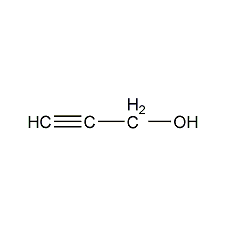
Structural formula
| Business number | 02UW |
|---|---|
| Molecular formula | C3H4O |
| Molecular weight | 56 |
| label |
propargyl alcohol, 2-propyn-1-ol, 2-propynyl alcohol, propargyl alcohol, Ethynylmethanol, 3-Hydroxymethylacetylene, Acetylene Methanol, Propargyl alcohol, propynol, 2-Propyny-1-ol, 2-propynyl alcohol, Aliphatic alcohols, ethers and their derivatives |
Numbering system
CAS number:107-19-7
MDL number:MFCD00002912
EINECS number:203-471-2
RTECS number:UK5075000
BRN number:506003
PubChem number:24887905
Physical property data
1. Properties: Colorless and transparent liquid, volatile and pungent odor.
2. Density (g/mL, 20/4℃): 0.9715
3. Relative vapor density (g/mL, air=1): 1.93
4. Melting point (ºC): -48
5. Boiling point (ºC, normal pressure): 114.5
6. Boiling point (ºC, 2.66kPa): 30
7. Refractive index (20ºC): 1.43064
8. Viscosity (mPa·s, 20ºC): 1.68
9. Flash point (ºC): 36
10. Vapor pressure (kPa, 20ºC): 1.55
11. Heat of combustion (KJ/mol): 1729.2
12. Solubility: miscible with water, benzene, chloroform, 1,2-dichloroethane, ether, ethanol, acetone, dioxane, tetrahydrofuran, pyridine, partially soluble in tetrachloride carbon, but insoluble in aliphatic hydrocarbons.
13. Relative density (20℃, 4℃): 0.9485
14. Refractive index at room temperature (n20): 1.4322
15. Liquid phase standard hot melt (J·mol-1·K-1): 153.9
Toxicological data
1. Acute toxicity: rat oral LD50: 70mg/kg; rabbit skin LD50: 16mg/kg
Rat inhalation LD50: 2000mg/m3/2H
Ecological data
BOD5 (five-day biological oxygen demand): 2% ThoD COD (chemical oxygen demand): 97% ThoD
Toxic to aquatic life. Can cause adverse consequences to the water environment.
2. Toxic. Severe irritation to skin and eyes.
Molecular structureData
1. Molar refractive index: 15.31
2. Molar volume (cm3/mol): 59.3
3. Isotonic specific volume (90.2K ): 147.2
4. Surface tension (dyne/cm): 37.9
5. Dielectric constant:
6. Dipole moment (10-24cm3):
7. Polarizability: 6.06
Compute chemical data
1. Reference value for hydrophobic parameter calculation (XlogP): None
2. Number of hydrogen bond donors: 1
3. Number of hydrogen bond acceptors: 1
4. Number of rotatable chemical bonds: 0
5. Number of tautomers: none
6. Topological molecule polar surface area 20.2
7. Number of heavy atoms: 4
8. Surface charge: 0
9. Complexity: 38.5
10. Number of isotope atoms: 0
11. Determine the number of atomic stereocenters: 0
12. Uncertain number of atomic stereocenters: 0
13. Determine the number of chemical bond stereocenters: 0
14. Number of uncertain chemical bond stereocenters: 0
15. Number of covalent bond units: 1
Properties and stability
1. Avoid heat. Avoid contact with strong oxidants, strong acids, strong bases, acid chlorides, and acid anhydrides.
2.Poisonous. Severe irritation to skin and eyes. Rat oral LD500.07g/kg. Protective glasses and gloves should be worn during operation.
Storage method
1. Store in a cool, ventilated warehouse. Keep away from fire and heat sources. The storage temperature should not exceed 30℃. Keep container tightly sealed. They should be stored separately from oxidants, acids, alkalis, and food chemicals, and avoid mixed storage. It should not be stored in large quantities or for long periods of time. Use explosion-proof lighting and ventilation facilities. It is prohibited to use mechanical equipment and tools that are prone to sparks. The storage area should be equipped with emergency release equipment and suitable containment materials. The “five pairs” management system for extremely toxic substances should be strictly implemented.
2. Since propargyl alcohol has a low flash point and can react violently in the presence of impurities, special attention should be paid to safety. For short-term storage and transportation, clean and rust-free steel containers can be used. For long-term storage, stainless steel, glass or phenolic resin lined containers should be used, and materials such as aluminum should be avoided. Store and transport according to regulations on flammable chemicals.
Synthesis method
1. Its preparation method is obtained by catalytic addition of acetylene and formaldehyde.
The above reactions are carried out in series-connected tubular reactors. Under acetylene pressure of 1.96MPa, use a piston pump to add the suspended powdery copper acetylene catalyst to a 5% to 6% formaldehyde aqueous solution. The reaction temperature is maintained at 100 to 125°C. The reaction liquid is separated by a gas-liquid separator. The excess Acetylene is recycled, and the reaction solution is filtered through a filter press to remove the copper acetylene catalyst, and then distilled to obtain a propargyl alcohol aqueous solution. After methanol is recovered, dehydration and fractionation are performed to obtain propargyl alcohol, with a content of more than 96%. The residual liquid in the distillation still is the by-product 1,4-butynediol, with a yield of 37% for propynyl alcohol and 50% for butynediol. %, the total yield is 87%. ![]()
In foreign countries, some use tetrahydrofuran or dimethyl Formamide is used as a solvent, and some use gas phase reaction (copper chromate is used as a catalyst under normal pressure) to reduce the formation of butynediol.
Purpose
1. Used as rust remover, chemical intermediate, corrosion inhibitor, solvent, stabilizer, etc. Organic synthesis intermediates, solvents, stabilizers for chlorinated hydrocarbons.
2.It can be used as hydrochloric acid and other industrial pickling corrosion inhibitors in the acidizing and fracturing process of oil and gas wells. It can be used as a corrosion inhibitor alone. It is best to combine it with substances that produce synergistic effects to obtain higher corrosion inhibition efficiency. For example, in order to increase the corrosion inhibition of acetylenic alcohols in dilute sulfuric acid solution, sodium chloride, potassium chloride, calcium chloride, potassium bromide, potassium iodide or zinc chloride are often added for compound use.
3.Can be used alone as a corrosion inhibitor. It is best to compound it with substances that produce synergistic effects to obtain better results. High corrosion inhibition efficiency. For example, in order to increase the corrosion inhibition effect of acetylenic alcohol in dilute sulfuric acid solution, it is recommended to add sodium chloride, potassium chloride, calcium chloride, potassium bromide, potassium iodide or zinc chloride.

 微信扫一扫打赏
微信扫一扫打赏

